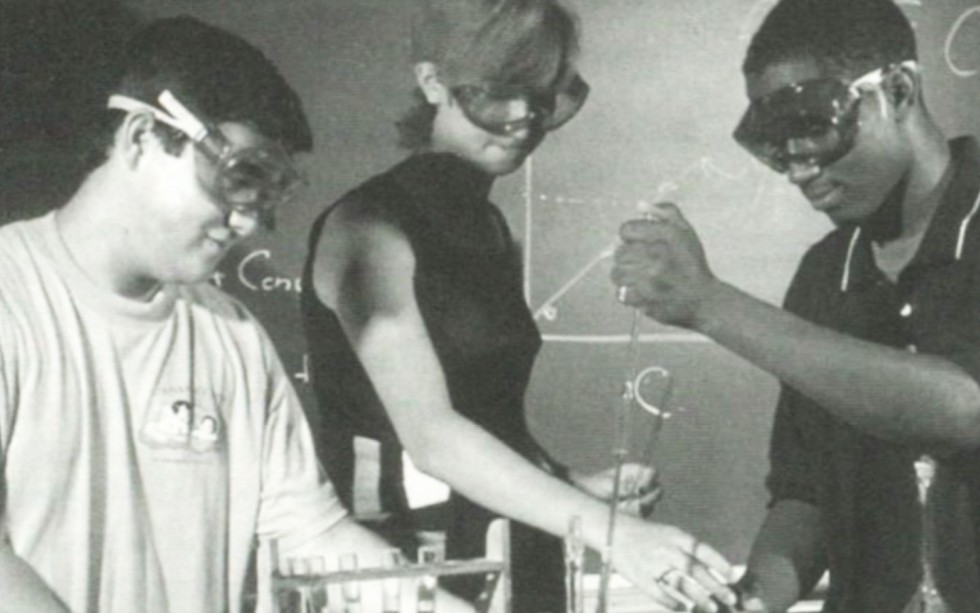This Will Do
A look at the Kenyon campus and how it grew.
Read The Story
The high school I went to was, in my opinion, academically behind a typical high school," says James J. Greenwood, a sophomore from Cleveland, Ohio, and a member of Kenyon's first Howard Hughes Medical Institute (HHMI) Science and Mathematics Workshop in 1998. "I graduated in a class of one hundred students, but the class started out in ninth grade with about nine hundred. The fact that I did 'well' by the school's standards meant that I was only 'average' by the standards of most high schools."
The College offers a number of programs that seek to ease the transition from high school to college for students like Greenwood. The HHMI program at Kenyon specifically seeks to introduce incoming first-year students to the study of math and science in the college environment. The two-week summer program addresses many of the elements that are perhaps most intimidating about college life, from living away from home to coping with academic demands.
For Greenwood and students like him, the early introduction to academic life at the College, and his success in the program, allayed some of his fears about not being adequately prepared for the college classroom.
While at Kenyon, the participants live with roommates in College residence halls. They meet future classmates, professors, administrators, and members of the support staff while learning to navigate around the campus. When classes begin in the fall, they already know how to find things in the library, how to use the computer for research and e-mail, and where classrooms and offices are located. They are, so to speak, the "experts" — the people to whom other students can turn for information and advice. The enhanced confidence such knowledge confers on the program's graduates is an asset that helps them through an experience that might otherwise seem overwhelming.
"For me, one of the best things about the program was that we came together as a group of strangers, but we came away as friends," says Meheret Birru, a sophomore from Pittsburgh, Pennsylvania, who plans to major in biology. Birru's comment is echoed by nearly all the participants. For many, it's a pleasant surprise to discover that a deep friendship can grow between people of different backgrounds and interests in so short a time.
The heart of the program is the introduction to the rigors of college-level academic life, particularly in math and science. During the course of the two weeks, students engage in three college-level laboratories, one each in biology, chemistry, and physics. Daily readings are assigned, and students are also responsible for two major projects: a multimedia presentation, using PowerPoint, based on library research on a medicinal herb, and a formal report from the lab experience of their preference.
"The technology in the labs at Kenyon just blew me away," says Nathan Hara, a first-year student from Sylvania, Ohio, who says he will most likely not major in a science. "Everything was at a higher level than anything I had experienced in high school."
In all three labs, students use the skills that will be required in any mathematics or science courses they attempt at the College. These include the abilities to follow a protocol, to generate data and record it accurately, to manipulate the data mathematically with the aid of computer software, and to interpret the results. Through the use of a range of techniques and principles, students hone their critical-thinking skills — skills that Kenyon professors emphasize across the curriculum and that will stand the students in good stead regardless of their ultimate choice of a field of concentration.
The formal lab report must include an abstract, background information, materials and methods, results, discussion of key points, and references. In many cases, this is the first time a student has been introduced to the preparation of such a report. The reports undergo many revisions, with plenty of instructor feedback, until they reach the quality expected in one of the College's lab courses.
In addition to the lab work, students and faculty members meet to discuss various scientific topics based on the assigned readings.
"The goal of these discussions is to get students thinking about some of the larger issues in science and to help them see the ways in which science affects our everyday lives," says Associate Professor of Physics Paula C. Turner. "We might talk about cloning or global warming or the ethics of genetic research. We also want to help the students to learn how to ask good questions."
Because of the nature of a liberal-arts education, some of the students who participate in the HHMI program will ultimately find fields of study that engage their intellect outside the math and science arena. But for all of them, their chances of success have been improved by their early introduction to the campus, to the people who make up the Kenyon community, and most especially to the other students with whom they will often remain close friends.
Image: Nathan Hara '04 (left) with Christine J. Yoon '03 and A. Lee Towns '03.
A look at the Kenyon campus and how it grew.
Read The StoryPresident Robert A. Oden Jr. reflects on Kenyon history in honor of the College's 175th anniversary.
Read The StoryPeter Dickson '69 explores the history of Mount Vernon's first brick hotel.
Read The StorySir Lloyd Tyrell-Kenyon, Lord Kenyon and Sixth Baron of Gredington, delivers the 1999 Founder's Day address.
Read The Story